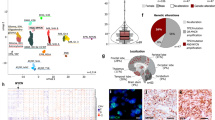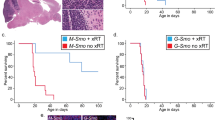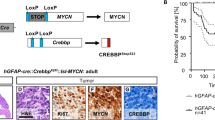Abstract
Inactivation of one Ptc1 allele predisposes humans and mice to spontaneous medulloblastoma development, and irradiation of newborn Ptc1 heterozygous mice results in dramatic increase of medulloblastoma incidence. While a role for loss of wild-type (wt) Ptc1 (LOH) in radiation-induced medulloblastomas from Ptc1neo67/+ mice is well established, the importance of this event in spontaneous medulloblastomas is still unclear. Here, we demonstrate that biallelic Ptc1 loss plays a crucial role in spontaneous medulloblastomas, as shown by high rate of wt Ptc1 loss in spontaneous tumors. In addition, remarkable differences in chromosomal events involving the Ptc1 locus in spontaneous and radiation-induced medulloblastomas suggest distinct mechanisms for Ptc1 loss. To assess when, during tumorigenesis, Ptc1 loss occurs, we characterized cerebellar abnormalities that precede tumor appearance in Ptc1neo67/+ mice. We show that inactivation of only one copy of Ptc1 is sufficient to give rise to abnormal cerebellar proliferations with different degree of altered cell morphology, but lacking potential to progress to neoplasia. Furthermore, we identify biallelic Ptc1 loss as the event causally related to the transition from the preneoplastic stage to full blown medulloblastoma. These results underscore the utility of the Ptc1neo67/+ mouse model for studies on the mechanisms of medulloblastoma and for development of new therapeutic strategies.
This is a preview of subscription content, access via your institution
Access options
Subscribe to this journal
Receive 50 print issues and online access
$259.00 per year
only $5.18 per issue
Buy this article
- Purchase on Springer Link
- Instant access to full article PDF
Prices may be subject to local taxes which are calculated during checkout




Similar content being viewed by others
References
Aszterbaum M, Epstein J, Oro A, Douglas V, LeBoit PE, Scott MP et al. (1999). Nat Med 5: 1285–1291.
Berman DM, Karhadkar SS, Hallahan AR, Pritchard JI, Eberhart CG, Watkins DN et al. (2002). Science 297: 1559–1561.
Chintagumpala M, Berg S, Blaney SM . (2001). Curr Opin Oncol 13: 154–159.
Corcoran RB, Scott MP . (2001). J Neurooncol 53: 307–318.
Dahmane N, Ruiz-i-Altaba A . (1999). Development 126: 3089–3100.
Eberhart CG, Burger PC . (2003). Brain Pathol 13: 376–385.
Goodrich LV, Milenkovic L, Higgins KM, Scott MP . (1997). Science 277: 1109–1113.
Hahn H, Wojnowski L, Zimmer AM, Hall J, Miller G, Zimmer A . (1998). Nat Med 4: 619–622.
Hutchinson F . (1995). J Mol Biol 254: 372–380.
Johnson RL, Rothman AL, Xie J, Goodrich LV, Bare JW, Bonifas JM et al. (1996). Science 272: 1668–1671.
Kim JY, Nelson AL, Algon SA, Graves O, Sturla LM, Goumnerova LC et al. (2003). Dev Biol 263: 50–66.
Kinzler KW, Vogelstein B . (1997). Nature 386: 761–763.
Knudson AG . (1993). Proc Natl Acad Sci USA 90: 10914–10921.
Knudson Jr AG . (1971). Proc Natl Acad Sci USA 68: 820–823.
Mancuso M, Pazzaglia S, Tanori M, Hahn H, Merola P, Rebessi S et al. (2004). Cancer Res 64: 934–941.
Nelson SL, Jones IM, Fuscoe JC, Burkhart-Schultz K, Grosovsky AJ . (1995). Radiat Res 141: 2–10.
Oliver TG, Read TA, Kessler JD, Mehmeti A, Wells JF, Huynh TT et al. (2005). Development 132: 2425–2439.
Packer RJ, Cogen P, Vezina G, Rorke LB . (1999). Neuro-oncol 1: 232–250.
Pazzaglia S . (2006). Cancer Lett 234: 124–134.
Pazzaglia S, Mancuso M, Atkinson MJ, Tanori M, Rebessi S, Di Majo V et al. (2002). Oncogene 21: 7580–7584.
Pazzaglia S, Pariset L, Rebessi S, Saran A, Coppola M, Covelli V et al. (2000). Mol Carcinog 27: 219–228.
Pazzaglia S, Tanori M, Mancuso M, Rebessi S, Leonardi S, Di Majo V et al. (2006). Oncogene 25: 1165–1173.
Ponomareva ON, Rose JA, Lasarev M, Rasey J, Turker MS . (2002). Cancer Res 62: 1518–1523.
Shoemaker AR, Moser AR, Midgley CA, Clipson L, Newton MA, Dove WF . (1998). Proc Natl Acad Sci USA 18: 10826–10831.
Turker MS, Pieretti M, Kumar S . (1997). Mutat Res 374: 201–208.
Uziel T, Zindy F, Xie S, Lee Y, Forget A, Magdaleno S et al. (2005). Genes Dev 19: 2656–2667.
Wallace VA . (1999). Curr Biol 9: 445–448.
Wetmore C, Eberhart DE, Curran T . (2000). Cancer Res 60: 2239–2246.
Yamada Y, Park MS, Okinaka RT, Chen DJ . (1996). Radiat Res 145: 481–490.
Zurawel RH, Allen C, Chiappa S, Cato W, Biegel J, Cogen P et al. (2000). Genes Chromosomes Cancer 27: 44–51.
Acknowledgements
We thank Dr Patrizio Sale at Department of Experimental Medicine and Pathology of University of Rome ‘La Sapienza’, Rome, Italy, for assistance with laser-capture microdissection. This work was supported by the Commission of the European Communities, Association Contract FI6R-CT-2003-508842 RISC-RAD.
Author information
Authors and Affiliations
Corresponding author
Rights and permissions
About this article
Cite this article
Pazzaglia, S., Tanori, M., Mancuso, M. et al. Two-hit model for progression of medulloblastoma preneoplasia in Patched heterozygous mice. Oncogene 25, 5575–5580 (2006). https://doi.org/10.1038/sj.onc.1209544
Received:
Accepted:
Published:
Issue Date:
DOI: https://doi.org/10.1038/sj.onc.1209544
Keywords
This article is cited by
-
Three dimensional reconstruction of the mouse cerebellum in Hedgehog-driven medulloblastoma models to identify Norrin-dependent effects on preneoplasia
Communications Biology (2022)
-
Sonic hedgehog accelerates DNA replication to cause replication stress promoting cancer initiation in medulloblastoma
Nature Cancer (2020)
-
Role of connexin43 and ATP in long-range bystander radiation damage and oncogenesis in vivo
Oncogene (2011)
-
Opposite modifying effects of HR and NHEJ deficiency on cancer risk in Ptc1 heterozygous mouse cerebellum
Oncogene (2011)
-
Radiation-induced adult medulloblastoma: a two-case report and review of the literature
Journal of Neuro-Oncology (2011)



